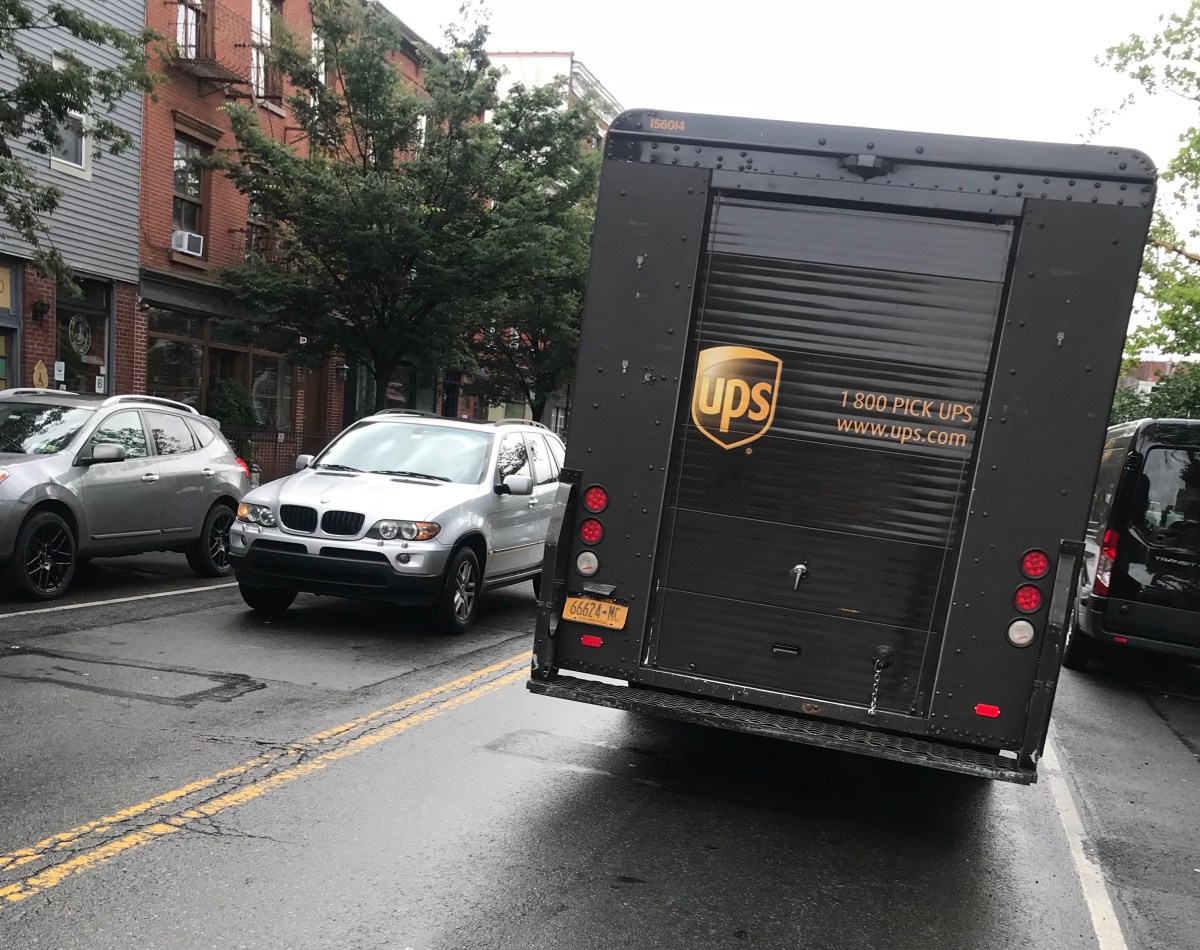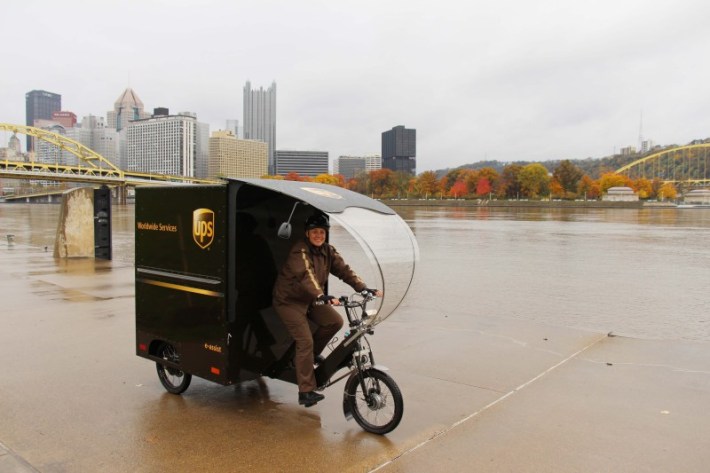Is UPS Finally Getting It? Top Exec Offers Some Evidence
11:23 AM EDT on April 22, 2019

This double-parked UPS truck created a dangerous situation. Photo: Gersh Kuntzman
Earlier this month, Thomas Madrecki, the director of Urban Innovation and Mobility for UPS, published an op-ed in Coord that called for "safer, less congested and more livable streets." But the piece was definitely not a stinging rebuke of his own company, whose drivers block bike lanes, park illegally and double-park all over the city. So Streetsblog Editor Gersh Kuntzman reached out to the D.C.-based Madrecki to fill in the yawning gap between his piece and reality. Here is a transcript of that interview, edited only for length and clarity.
Gersh Kuntzman: Your piece opened with what I thought was a salvo against UPS: "As a cyclist myself, I frequently remark that viewing the transportation environment as a cyclist distinctly changes your point of view on things. It’s a shift in perspective that forces you to confront what works and what doesn’t — sometimes even to the point of peril/potential harm as you navigate from Point A to Point B." So you get it, right?
Thomas Madrecki: I pretty much bike every day. It's mildly terrifying to leave home.
GK: The biggest problem we cyclists face is your trucks are all over the place. In the Coord piece, you state that as a UPS driver, "you know that there’s limited parking, everywhere you go — and that frequently, because of e-commerce, you’re not just going to places with clearly marked loading zones." So why isn't UPS fighting the city every day to create more loading zones and less on-street storage of private cars.
TM: Loading zones in every city are different. in Chicago, loading zones were created because a business would request one in front. Then, even if that store closed 30 years ago, there might be a loading zone still there. But almost everywhere, there just aren't enough. The idea of a loading zone needs to be revisited. If you think about what freight was 20 years ago, UPS was mostly a business-to-business company. We're now mostly business-to-consumer. That means every house is basically a freight recipient or a freight generator today. There is a plethora of free parking for residents, so of course, the UPS truck has to double-park. There is literally nowhere to go. That's the reality today. Until a city is brave enough to get rid of personal vehicle spots, this will be the problem.
GK: How does New York City compare to other cities?
TM: It is amazing to me that there is so much free parking. Why can you drive into Nolita and just hang out all day while your car just sits there? You don't need that parking. There are other transportation options, like subways or buses or Citi Bike. The use of the curb could be allocated to other things that don't have that other mode: restaurant deliveries, trucks, freight, or allocating curb space to e-scooters or bike share.
GK: So, again, you mention in the Coord piece that UPS is facing incredible challenges that have been "accelerated by e-commerce growth and the rapid rise of home delivery expectations. More packages than ever before need to be delivered, and those packages are less consolidated to single addresses than ever before, too." But isn't it your job to demand changes by local governments so that you're part of the solution, not part of the problem?
TM: That's why my role exists. When I talk to government, I say that freight is the red-headed stepchild of urban planning. There's a misunderstanding about how UPS functions. People always show me pictures of two UPS trucks next to each other. Well, that's because they're both full. There's that much stuff coming into that area that we needed to send two trucks. Or people say, "Why doesn't the driver park two blocks away and then use hand trucks?" If there's no loading zone and he has to push two hand trucks, you can't plausibly think he's going to park two blocks away.
GK: I plausibly think that. I think that maybe you are asking your drivers to deliver too many packages, forcing them to park at the most convenient spot for them. I've been told that the drivers can't come back to the depot until the truck is empty. You should give them smaller trucks so they don't have to cut corners.
TM: What a driver is looking to do is balance the efficiency with the volume that he has. If you're delivering kegs of beer, for example, it's even more implausible that the delivery worker will walk two blocks. We are trying to deliver the maximum possible, but also balance it with keeping the network moving. If our vehicles are too small, we'll have to add more of them. If we used small van, we would need two-and-a-half times more vans.
GK: In the Coord piece, you also said that UPS pays "its fair share in parking tickets." You know that's not true because the city's Stipulated Fine Program reduces your fines. Our own study showed that UPS alone might have saved $15 million last year.
TM: Well, drivers in New York are responsible for tickets that are clear safety issues, such as running a red light. We've done that internally. The Stipulated Fine Program was arrived at between the carriers and the city to have something that is cost-neutral. We don't contest tickets [for double-parking] in court, so we don't take up the city's time. It should come out as neutral.
GK: So why, at long last, do your trucks not even use loading zones or pull in at pumps when space is available on the curb?
TM: Our drivers are advised not to back up the vehicle. That's the number one cause of avoidable crashes. The best practice that comes out of that is that loading zones shouldn't be in the middle of the street, but should be where they can be easily entered and exited. There are very nitty-gritty design guidelines, but streets are done by planners and engineers, so what if you applied UX design principles to city streets. so we can figure out how drivers interact with the streets. Streets would look and feel differently than they do today. We need a people-centric approach. The curb is the epitome of the free market and it should be priced to incentivize one mode over another.
GK: In the Coord piece, you boasted of "30 cycle logistic pilot projects all around the world, using our innovative e-assist cargo bikes to deliver in the last mile." We don't have that here.
TM: No, but we are actively discussing it. We just deployed a cargo bike in Seattle. and we are talking to several other cities.
GK: How does it work?

TM: I'll send you a video link of our cargo bike system. The bike itself gets a lot of attention, but the actual innovation is that instead of a truck going from depot to multiple places in the city, this system creates a staging area adjacent to the area where you're going to deliver. There's a requirement of some curb space for a staging area, which could be provided by the city or a local real-estate developer. The truck brings a trailer-style caboose to the staging area. That trailer has four modular boxes on it. Each of those boxes is put on the cargo bike one by one. So the truck driver drops the trailer in the staging area and the bike is already there. so that bike rider reports there and reports to the mini hub. But the key is dedicated curb space for staging. The original truck picks up the now-empty mini trailer at the end of the day.
GK: But we wouldn't even need innovations if there was simply more curb space set aside for deliveries because we have eliminated on-street storage of private vehicles in the public right of way.
TM: I love it. I mean, of course that sounds selfish if someone at UPS endorses that vision, but I think the underlying thing there is that transportation is about people, goods and services, not cars. My view is that certain tensions/curb conflicts, etc. will always exist. But at the same time, I think there’s often a misunderstanding that we don’t have any shared interest/mutual benefit in reducing congestion, rethinking the curb, etc. Not to be all “kumbaya,” but I don’t think cyclists, pedestrians, transit advocates, urban freight and more have to be “opposed.” Transportation is a complex, multifaceted problem and I think working together we can better understand each other and how to design for a better future.
This piece was the work of the Streetsblog staff.
Read More:
Stay in touch
Sign up for our free newsletter
More from Streetsblog New York City
Stockholm Leader’s Message to NYC: ‘Congestion Pricing Just Works’
"In Stockholm, people really thought that congestion pricing would be the end of the world, the city will come to a standstill, no one would be able to get to work anymore and all the theaters and shops would just go bankrupt. None of that happened."
Friday’s Headlines: Trump Trial Trumps Safety Edition
Is anyone going to bother to fix the dangerous mess on the streets and plazas around the Trump trial? Plus more news.
Adams Offers Bare Minimum to Seize Congestion Pricing’s ‘Space Dividend’ Opportunity
The mayor's list of projects supposedly meant to harness congestion pricing's expected reduction in traffic is mostly old news, according to critics.
OPINION: Congestion Pricing Will Help My Family Get Around As We Navigate Cancer Treatment
My partner was recently diagnosed with cancer. Congestion pricing will make getting her to treatment faster and easier.





